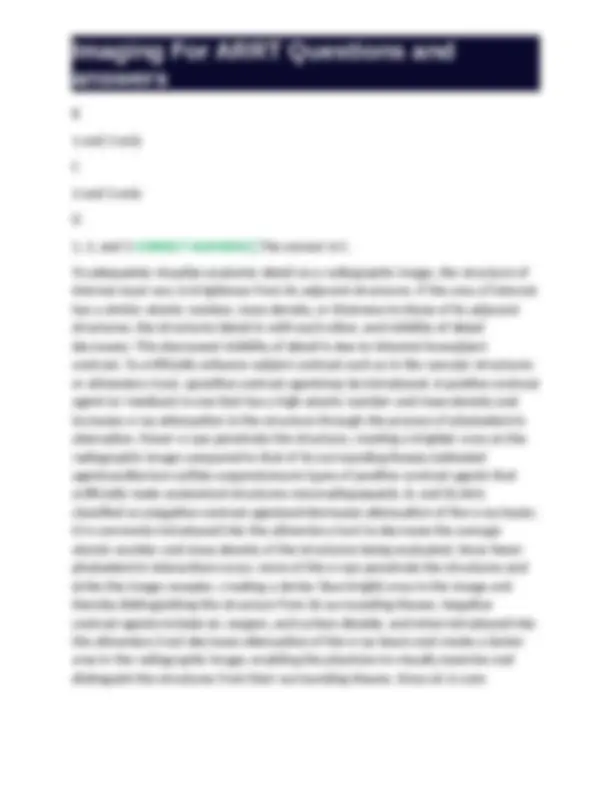





















Study with the several resources on Docsity

Earn points by helping other students or get them with a premium plan


Prepare for your exams
Study with the several resources on Docsity

Earn points to download
Earn points by helping other students or get them with a premium plan
Community
Ask the community for help and clear up your study doubts
Discover the best universities in your country according to Docsity users
Free resources
Download our free guides on studying techniques, anxiety management strategies, and thesis advice from Docsity tutors
A comprehensive set of questions and answers on various topics related to imaging for the arrt (american registry of radiologic technologists) exam. Topics covered include image acquisition contrast resolution, rectifiers, automatic exposure control, pacs (picture archiving and communication system), and more. The questions cover a wide range of topics, including the impact of milliampere-seconds on x-ray production, the use of battery-operated units, the factors affecting spatial resolution, and the effects of excessive anode heating. Useful for university students preparing for the arrt exam, particularly those studying radiology or medical imaging.
Typology: Exams
1 / 27

This page cannot be seen from the preview
Don't miss anything!




















Which of the following represents the image acquisition contrast resolution? A Pixel. B Pixel size. C Pixel pitch. D Bit depth CORRECT ANSWERS✅ The answer is D. Pixel bit depth is known as the number of bits within a pixel which presents the number of gray tones that pixel can produce (D). The number of shades of gray can be calculated by raising 2 to the power of the bit depth, or 210 or 1, shades of gray. A pixel is the smallest element in a digital image (A). Pixel size is related to the spatial resolution (B). Pixel pitch is the distance between the centers of two adjacent pixels (C). The smaller the pixel and pixel pitch the greater the resolution. If a 30/23/15 cm trifocus image intensifier is operated in the 15-cm mode, the fluoroscopic image will be magnified by a factor of A
B
C
2.0 CORRECT ANSWERS✅ The answer is D. The degree of magnification (magnification factor [MF]) is found by dividing the full-size input diameter (30 cm) by the selected input diameter (15 cm). MF = 30 cm / 15 cm = 2.0 (D). If the image intensifier was operated in the 23-cm mode, the MF would be 30 cm / 23 cm = 1.3 (B). If the image intensifier was operated in the 30-cm mode, the MF would be 30 cm / 30 cm = 1.0 (A). Changes in milliampere-seconds can affect all the following except A quantity of x-ray photons produced B exposure rate C receptor exposure D spatial resolution CORRECT ANSWERS✅ The Correct Answer is: D Milliampere-seconds (mAs) are the product of milliamperes (mA) and exposure time (seconds). Any combinations of milliamperes and time that will produce a given milliampere-seconds value will produce identical receptor exposure. This is known as the reciprocity law. The milliampere-seconds value is a quantitative factor. The mAs is directly proportional to x-ray-beam intensity, exposure rate, quantity, or number of x-ray photons produced and patient dose. If the mAs value is doubled, twice the receptor exposure and twice the patients dose. If the milliampere-seconds value is cut in half, the receptor exposure and patient dose are cut in half. The milliampere-seconds value has no effect on spatial resolution.
1 and 3 are correct B 2 and 3 are correct C 4 and 5 are correct D 2 and 5 are correct CORRECT ANSWERS✅ The answer is A. Two types of image distortion are size and shape. Size distortion is magnification, which is impacted by OID and SID. Shape distortion is impacted by alignment of the x-ray tube, anatomic part, and IR. If the anatomic part is at an angle with respect to the x-ray tube and IR, foreshortening occurs. If the x-ray tube is angled with respect to the part and IR, elongation occurs. CR alignment also impacts image distortion. Anatomic parts in the path of the actual central ray have the least distortion, while parts imaged further and further away from the central ray by divergent x-ray photons experience more and more distortion. The purpose of magnification fluoroscopy is to: A Enhance the image in order to facilitate diagnostic interpretation B Decrease patient dosage C Decrease fluoroscopy time D
Increase efficiency of X-ray production CORRECT ANSWERS✅ The Correct Answer is: A Magnification of the image is an important feature of the image intensifier. The purpose of magnification fluoroscopy is to enhance the image in order to assist the radiologist in diagnostic interpretation (A). Magnification mode in fluoroscopy actually increases patient dosage (B), as more radiation is necessary to produce the brightness levels needed to view the images. The magnification mode should therefore be used only when necessary to enhance diagnostic interpretation of small specific anatomical areas in question. Fluoroscopy time should be limited in order to ensure the practice of ALARA. However, the time needed to evaluate the anatomical areas in question is not limited to a certain time (C). Magnification fluoroscopy neither increases or decreases fluoroscopic evaluation time. X-ray production efficiency is a function of the generator and X-ray tube providing the necessary X-ray energy to produce the fluoroscopic image. Magnification fluoroscopy, therefore, does not alter the efficiency of X-ray production (D). Using a 48-in. SID, how much OID must be introduced to magnify an object two times? A 8-in. OID B 12-in. OID C 16-in. OID D 24-in. OID CORRECT ANSWERS✅ The Correct Answer is: D Magnification radiography may be used to delineate a suspected hairline fracture or to enlarge tiny, contrast-filled blood vessels. It also has application in
these units to ensure the safety of others and to avoid damaging structures within the facility. Breast tissue is compressed in mammographic procedures to improve contrast resolution by reducing the production of Compton scatter. Which of the following also reduces Compton scatter production? A Using a grid B Increasing kVp C Decreasing tissue density (mass/volume) D Increasing average atomic number of tissue irradiated CORRECT ANSWERS✅ The answer is C. Compton scatter is a quantum mechanical phenomenon, and therefore is a randomly occurring event. The probability that Compton scatter occurs can be influenced by several factors. Tissue density and tissue thickness both have a direct relationship, and as they decrease, the probability of Compton scatter decreases (C). Atomic number is a factor that influences photoelectric interaction, but does not increase or decrease Compton scatter production (D). Finally, increasing kVp increases Compton scatterrelativeto photoelectric absorption (B). A better way to say this is kVp exponentially decreases photoelectric effects, but only mildly decreases Compton scattering. Grids do not affect the production of scatter, they clean up scatter that has already formed (A).
There are two types of automatic exposure control: photodiode and the more common parallel plate ionization chamber. How are they positioned? A Both are between the image receptor and the patient B Both are behind the image receptor C The photodiode type is situated between the patient and the image receptor, while the ionization chamber is behind the image receptor D The ionization chamber type is situated between the patient and the image receptor, while the photodiode is behind the image receptor CORRECT ANSWERS✅ he answer is D. The AEC measures the quantity of radiation and is calibrated to terminate the exposure when enough radiation to yield a diagnostic image has been deposited on the image receptor. The ionization chamber type is situated between the patient and the image receptor (D). The ionization chamber is relatively radiolucent compared to the photodiode type and will not interfere with the capture of the remnant beam significantly. By contrast, the photodiode type has to be coupled to a fluorescent screen, which will absorb a large percentage of the remnant radiation, and therefore has to be placed behind the image receptor so as not to degrade the remnant beam signal. The other answer choices are incorrect as per the previous explanation (A, B, and C). Regardless of pixel size, which of the following factors influence spatial resolution? (select the two that apply) A
Pair archiving and communication system CORRECT ANSWERS✅ The answer is A. The picture archiving and communication system is an integral part of the digital radiology imaging department (A). A PACS can generally be divided into acquisition, display, and storage systems. Storage is a challenge in any Radiology department because of the increasing size of modalities. PACS is an electronic network for communication between the image acquisition modalities, display stations, and storage. The other answer choices are incorrect as per the previous explanation (B, C, and D). Better resolution is obtained with A high SNR. B low SNR. C windowing. D smaller matrix. CORRECT ANSWERS✅ The Correct Answer is: A Spatial resolution increases as SNR (signal-to-noise ratio) increases. A high SNR (e.g., 1000:1) indicates that there is far more signal than noise. A lower SNR (e.g., 200:1) indicates a "noisy" image. Windowing is unrelated to resolution; it permits post-processing image manipulation. Image matrix has a great deal to do with resolution. A larger image matrix (1800 × 1800) offers better resolution than a smaller image matrix (700 × 700). Smaller image matrices look "pixelly."
Prolonged heating of the x-ray tube filament when preparing for a radiographic exposure may lead to which of the following?
excessively long backup time C incorrect centering D inadequate beam restriction E use of large focal spot CORRECT ANSWERS✅ The answer is A, C, and D. Factors affecting histogram appearance, and reflected in the EI, include selection of the correct processing algorithm (e.g., chest vs. femur vs. cervical spine), and changes in scatter, SID, OID, and collimation—in short, anything that affects scatter and/or dose (A, C, and D). Inadequate collimation results in signals outside the anatomic area being included in the exposure data recognition (EDR)/ histogram analysis, potentially resulting in a variety of analysis errors including excessively light, dark, or noisy images. One other factor is delay in PSP processing. A delay in processing can result in fading of the image. Histogram analysis errors are less common in DR systems where only exposed pixels are analyzed, rather than entire plate analysis as in CR systems. Backup time is related to AEC (B). Focal spot size is related to spatial resolution (E). Neither of these is related to histogram analysis. Which of the following decrease attenuation of the x-ray beam?
1 and 3 only C 2 and 3 only D 1, 2, and 3 CORRECT ANSWERS✅ The answer is C. To adequately visualize anatomic detail on a radiographic image, the structure of interest must vary in brightness from its adjacent structures. If the area of interest has a similar atomic number, mass density, or thickness to those of its adjacent structures, the structures blend in with each other, and visibility of detail decreases. This decreased visibility of detail is due to inherent lowsubject contrast. To artificially enhance subject contrast such as in the vascular structures or alimentary tract, apositive contrast agentmay be introduced. A positive contrast agent (or medium) is one that has a high atomic number and mass density and increases x-ray attenuation in the structure through the process of photoelectric absorption. Fewer x-rays penetrate the structure, creating a brighter area on the radiographic image compared to that of its surrounding tissues.Iodinated agentsandbarium sulfate suspensionsare types of positive contrast agents that artificially make anatomical structures moreradiopaque(A, B, and D).Airis classified as anegative contrast agentand decreases attenuation of the x-ray beam. It is commonly introduced into the alimentary tract to decrease the average atomic number and mass density of the structures being evaluated. Since fewer photoelectric interactions occur, more of the x-rays penetrate the structures and strike the image receptor, creating a darker (less bright) area in the image and thereby distinguishing the structure from its surrounding tissues. Negative contrast agents include air, oxygen, and carbon dioxide, and when introduced into the alimentary tract decrease attenuation of the x-ray beam and create a darker area in the radiographic image, enabling the physician to visually examine and distinguish the structures from their surrounding tissues. Since air is cons
1 and 3 only C 2 and 3 only D 1, 2, and 3 CORRECT ANSWERS✅ The answer is B. X-ray beam filtrationexists in the form of inherent and added filtration. This is required by regulatory agencies to reduce patient dose. To achieve this, two types of filtration are required.Inherent filtrationthat comes with the x-ray tube housing and tube includes the x-ray tube window, oil in the x-ray tube housing, and housing port. Added filtration includes an aluminum (Al) plate and the collimator mirror. Both the inherent and added filtration (total filtration) must be equivalent to 2.5 mm Al of filtration for diagnostic radiography, and if it were not present, there would be increased patient dose.As a result of the inherent and added filtration, lower-energy (long wavelength) x-rays are absorbed, thereby reducing the patient's skin entrance dose (ESD) and other superficial tissue dose. Additionally, if filtration were not present, the average energy of the x-ray beam would decreaseas low-energy x-rays would not be absorbed (B).Overexposure of the IR, assuming the appropriate technical factors are used, would not be possible due to absorption of the low-energy x-rays that are not able to penetrate the part of interest (A, C, and D). Electronic imaging terms used to indicate the intensity of radiation reaching the IR include
1 and 2 only C 2 and 3 only D 1, 2, and 3 CORRECT ANSWERS✅ The Correct Answer is: B Computed radiography (CR) offers wide latitude and automatic optimization of the radiologic image. When AEC is not used, CR can compensate for about 80% underexposure and 500% overexposure. This can be an important advantage in trauma and mobile radiography. The radiographer still must be vigilant in patient dose considerations—overexposure, though correctable, results in increased patient dose; underexposure results in decreased image quality owing to increased image noise. CR systems provide an exposure indicator: an S (sensitivity) number, exposure index EI, or other relative exposure index depending on the manufacturer used. The manufacturer usually provides a chart identifying the acceptable range the exposure indicator numbers should be within for various examination types. For example, a high S number often is related to underexposure, whereas a high EI number is related to overexposure. Field of view (FOV) refers to the anatomic area being visualized. The exposure factors of 300 mA, 0.07 second, and 95 kVp were used to deliver a particular analog receptor exposure and contrast. A similar analog x-ray image can be produced using 500 mA, 80 kVp, and A 0.01 second. B 0.04 second.
possible field recognition error (B). The keys to multiple fields on one IP are symmetry and uniform distribution. One should only use 3-on-1 distribution for fingers and toes where the amount of intrafield scatter is low. If larger body structures are done 3-on-1, the intrafield scatter will reduce the contrast unless the unexposed areas are shielded between exposures (C). The specific location of any projection on an image plate does not discount the importance of including one projection on one image plate (D). Which of the following pathologies would justify a decrease in technique? A Ascites B Pneumothorax C Hydrocephalus D Atelectasis CORRECT ANSWERS✅ The answer is B. Ascites (A), Hydrocephalus (C), and Atelectasis (D) are all additive conditions that require an increase in technique. A patient who has a Pneumothorax results in the lung field being easier to penetrate. To compensate for this condition, the technique should be decreased so the anatomy of interest is not overexposed (B). The X-ray scintillator layer used with indirect flat-panel digital detectors is usually either _____________ or ______________. A Silicon dioxide, silver halide
Cesium iodide, gadolinium oxysulfide C Yttrium oxysulfide, barium fluoride D Amorphous silicon dioxide, barium platinocyanide CORRECT ANSWERS✅ The correct answer is: (B) The X-ray scintillator used in the indirect flat-panel digital detector is usually either cesium iodide (CsI) or gadolinium oxysulfide (Gd 2 O 2 S). These phosphors are not new to x-ray imaging; they have been used in x-ray image intensifiers (CsI) and in rare-earth intensifying screens (Gd 2 O 2 S) for many years (B). Silicon dioxide is a substance used in sonographic imaging, whereas silver halide was found in radiographic film emulsions (A). Yttrium oxysulfide was a phosphor material used in rare earth radiographic screens, whereas barium fluoride is a component of barium fluoride bromide crystals coated with europium in computed radiography (CR) PSPs (C). Amorphous silicon dioxide is a material used in the photodiodes used in indirect digital flat panel detectors, whereas barium platinocyanide was a phosphor material used in experiments conducted by Wilhelm Roentgen. Each manufacturer's software system determines the gray scale available for when the x-ray image is displayed. Which of the following terms best describes this definition? A Modulation transfer function B Detective quantum efficiency